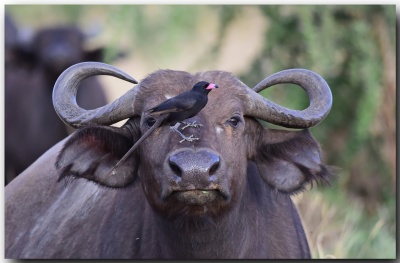(Picture of juvenile. Imp sizes. Links. C/right. References updated) |
|||
| (11 intermediate revisions by 8 users not shown) | |||
| Line 1: | Line 1: | ||
| + | [[Image:Piapiac_obasanmi_gambia.jpg|thumb|550px|right|Photo © by {{user|obasanmi|obasanmi}}<br /> The [[Gambia]], June 2007]] | ||
| + | '''Alternative name: Black Magpie''' | ||
| + | ;[[: Category:Ptilostomus|Ptilostomus]] afer | ||
| + | ==Identification== | ||
| + | [[Image:DSC 6244.JPG|thumb|400px|right|Juvenile<br />Photo © by {{user|volker+sthamer|volker sthamer}}<br />Kidepo NP, [[Uganda]], January 2019]] | ||
| + | 35 - 42cm (13¾-16½ in). A distinctive African corvid: | ||
| + | * Very long, graduated tail with ten stiff feathers, blackish-brown | ||
| + | * Stout bill with strongly arched [[Topography#Beaks|culmen]] | ||
| + | * Black plumage with bluish or purplish sheen | ||
| + | * Violet-blue or purple iris with red-brown outer rim | ||
| + | * Black legs | ||
| + | Sexes similar. Juveniles have a pinkish bill and brown eyes. | ||
| − | |||
| − | |||
| − | |||
| − | |||
| − | |||
==Distribution== | ==Distribution== | ||
| − | + | Central [[Africa]] from [[Senegal]] on the west coast, eastwards in a broad band to [[Sudan]] and southern [[Ethiopia]]. <br /> | |
| + | Widespread and common in parts of its range. | ||
==Taxonomy== | ==Taxonomy== | ||
| − | + | This is a [[Dictionary_M-S#M|monotypic]] species<sup>[[#References|[1]]]</sup>..<br /> | |
| + | Has been thought to belong to the [[:Category:Sturnidae|starlings]] but recent studies show that is most closely related to the Central Asian ground jays ([[:Category:Podoces|''Podoces'']]) and to [[Stresemann's Bush Crow]] (Ericson et al., J. Avian Biol 36: 222-234, 2005). | ||
==Habitat== | ==Habitat== | ||
| − | + | Savanna with trees and patches of woodland. Forages in cultivated land with fields and pasture and small associated towns and villages. | |
==Behaviour== | ==Behaviour== | ||
| − | + | ====Diet==== | |
| − | + | Diet includes insects, invertebrates, carrion and fruit.<br /> | |
| − | + | Forages mainly on the ground, usually in small to rather big, noisy groups. | |
| − | + | ====Breeding==== | |
| − | + | The breeding season depends on the local rains. They build their nests in trees, often a palm, and use palm leaves, grass stems, and mud to form a cup which is lined with palm fibre. 3-7 pale blue eggs are laid. Reports on cooperative breeding with up to five adults feeding three nestlings. | |
| − | + | ====Movements==== | |
| − | + | Mainly a resident species but some wandering seems to occur. | |
| + | ==References== | ||
| + | #{{Ref-Clements6thAug18}}#{{Ref-HBWVol14}} | ||
| + | {{Ref}} | ||
==External Links== | ==External Links== | ||
| − | + | {{GSearch|Ptilostomus+afer}} | |
| − | [[Category:Birds]] | + | [[Category:Birds]][[Category:Ptilostomus]] |
Latest revision as of 22:53, 27 February 2019
Alternative name: Black Magpie
- Ptilostomus afer
Identification
35 - 42cm (13¾-16½ in). A distinctive African corvid:
- Very long, graduated tail with ten stiff feathers, blackish-brown
- Stout bill with strongly arched culmen
- Black plumage with bluish or purplish sheen
- Violet-blue or purple iris with red-brown outer rim
- Black legs
Sexes similar. Juveniles have a pinkish bill and brown eyes.
Distribution
Central Africa from Senegal on the west coast, eastwards in a broad band to Sudan and southern Ethiopia.
Widespread and common in parts of its range.
Taxonomy
This is a monotypic species[1]..
Has been thought to belong to the starlings but recent studies show that is most closely related to the Central Asian ground jays (Podoces) and to Stresemann's Bush Crow (Ericson et al., J. Avian Biol 36: 222-234, 2005).
Habitat
Savanna with trees and patches of woodland. Forages in cultivated land with fields and pasture and small associated towns and villages.
Behaviour
Diet
Diet includes insects, invertebrates, carrion and fruit.
Forages mainly on the ground, usually in small to rather big, noisy groups.
Breeding
The breeding season depends on the local rains. They build their nests in trees, often a palm, and use palm leaves, grass stems, and mud to form a cup which is lined with palm fibre. 3-7 pale blue eggs are laid. Reports on cooperative breeding with up to five adults feeding three nestlings.
Movements
Mainly a resident species but some wandering seems to occur.
References
- Clements, J. F., T. S. Schulenberg, M. J. Iliff, D. Roberson, T. A. Fredericks, B. L. Sullivan, and C. L. Wood. 2018. The eBird/Clements checklist of birds of the world: v2018. Downloaded from http://www.birds.cornell.edu/clementschecklist/download/
- Del Hoyo, J, A Elliott, and D Christie, eds. 2009. Handbook of the Birds of the World. Volume 14: Bush-shrikes to Old World Sparrows. Barcelona: Lynx Edicions. ISBN 978-8496553507
Recommended Citation
- BirdForum Opus contributors. (2024) Piapiac. In: BirdForum, the forum for wild birds and birding. Retrieved 26 April 2024 from https://www.birdforum.net/opus/Piapiac





